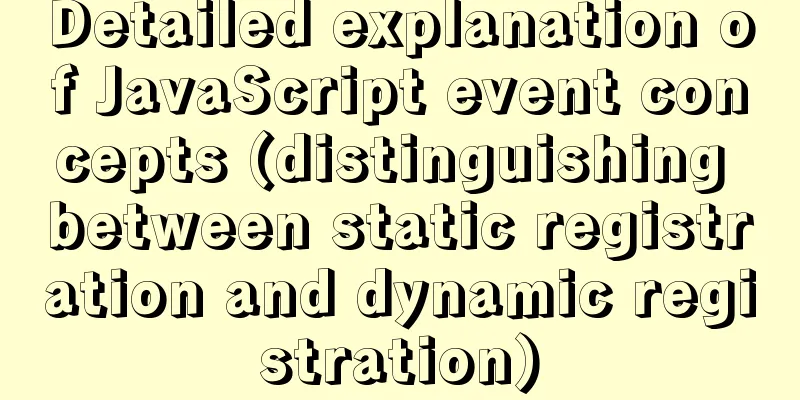Detailed explanation of JavaScript event concepts (distinguishing between static registration and dynamic registration)

Events in jsWhat is an event? Events are responses to interactions between computer input devices and pages, which we call events. Event Type
Common events
Event Registration What is event registration (binding)?
Basic steps for dynamic registration: 1. Get the tag object Static and dynamic registration examples onload loading completion eventStatic binding:
<!DOCTYPE html>
<html lang="en">
<head>
<meta charset="UTF-8">
<title>Static Registration</title>
<script type="text/javascript">
// onload event method function onloadFun() {
alert('Statically register onload event, all codes');
}
</script>
</head>
<!--Statically register the onload event. The onload event is an event that is automatically triggered after the browser parses the page. The attribute of the body tag is registered through this attribute-->
<body content="onloadFun();">
</body>
</html>
Dynamic Binding:Fixed writing method, through window.onload(){} method, calling the method in curly braces
<!DOCTYPE html>
<html lang="en">
<head>
<meta charset="UTF-8">
<title>Dynamic Registration</title>
<script type="text/javascript">
// Dynamic registration of onload event. It is a fixed writing method window.onload = function () {
alert("Dynamically registered onload event");
}
</script>
</head>
<body>
</body>
</html>
onclick click eventFor example, we can better understand the difference between the two definitions from this example. onclick static binding event
<!DOCTYPE html>
<html lang="en">
<head>
<meta charset="UTF-8">
<title>Title</title>
<script type="text/javascript">
function onclickFun() {
alert("Statically register onclick event");
}
</script>
</head>
<body>
<!--Statically register the onClick event through the button's onclick attribute-->
<button onclick="onclickFun();">Button 1</button>
</body>
</html>
onclick dynamic binding event
<!DOCTYPE html>
<html lang="en">
<head>
<meta charset="UTF-8">
<title>Title</title>
<script type="text/javascript">
window.onload = function () {
//getElementById gets the tag object through the id attribute var btnObj = document.getElementById("btn01");
// 2 through the tag object. Event name = function(){}
btnObj.onclick = function () {
alert("Dynamically registered onclick event");
}
}
</script>
</head>
<body>
<button id="btn01">Button 2</button>
</body>
</html>
The above is the detailed content of the detailed explanation of the concept of JavaScript events (distinguishing between static registration and dynamic registration). For more information about JavaScript events, please pay attention to other related articles on 123WORDPRESS.COM! You may also be interested in:
|
<<: 27 Linux document editing commands worth collecting
>>: MySQL Optimization: Cache Optimization
Recommend
Install Docker on Linux (very simple installation method)
I have been quite free recently. I have been doin...
Detailed explanation of VUE Token's invalidation process
Table of contents Target Thought Analysis Code la...
One command lets you understand the common parameters of the read command in the shell
We know that there are two ways to receive incomi...
Centos8 builds nfs based on kdc encryption
Table of contents Configuration nfs server (nfs.s...
Vue implements left and right sliding effect example code
Preface The effect problems used in personal actu...
Win10 install Linux ubuntu-18.04 dual system (installation guide)
I installed a Linux Ubuntu system on my computer....
Analysis of Mysql transaction characteristics and level principles
1. What is a transaction? A database transaction ...
N ways to center elements with CSS
Table of contents Preface Centering inline elemen...
Installation tutorial of docker in linux
The Docker package is already included in the def...
How to write elegant JS code
Table of contents variable Use meaningful and pro...
A method of hiding processes under Linux and the pitfalls encountered
Preface 1. The tools used in this article can be ...
Solution to the problem that Centos8 cannot install docker
Problem [root@zh ~]# [root@zh ~]# [root@zh ~]# yu...
Example of using MySQL to count the number of different values in a column
Preface The requirement implemented in this artic...
Complete steps to use vue-router in vue3
Preface Managing routing is an essential feature ...
Summary of some efficient magic operators in JS
JavaScript now releases a new version every year,...









